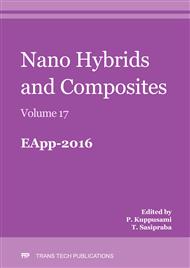[1]
Choi SUS, Enhancing thermal conductivity of fluids with nanoparticles. In: Singer DA, Wang HP, editors. Developments and applications of non-Newtonian flows. San Francisco, USA: American Society of Mechanical Engineers, Fluids Engineering Division (Publication) FED; (1995).
Google Scholar
[2]
Omer A. Alawi, Nor Azwadi Che Sidik, Influence of particle concentration and temperature on thermophysical properties of CuO/R134a nanorefrigerant, International Communications in Heat and Mass Transfer, 58(2014) 79-84.
DOI: 10.1016/j.icheatmasstransfer.2014.08.038
Google Scholar
[3]
I.M. Mahbubul, R. Saidur, M.A. Amalina Thermal conductivity, viscosity and density of R141b refrigerant based nanofluid, 5th BSME International Conference on Thermal Engineering, Procedia Engineering 56(2013) 310-315.
DOI: 10.1016/j.proeng.2013.03.124
Google Scholar
[4]
I.M. Mahbubul, S.A. Fadhilah, R. Saidur, K.Y. Leong, M.A. Amalina, Thermophysical properties and heat transfer performance of Al2O3/R-134a nanorefrigerants, International Journal of Heat and Mass Transfer 57(2013) 100-108.
DOI: 10.1016/j.ijheatmasstransfer.2012.10.007
Google Scholar
[5]
A. Nasiri, M. Shariaty-Niasar, A.M. Rashidi, R. Khodafarin Effect of CNT structures on thermal conductivity and stability of nanofluid, International Journal of Heat and Mass Transfer 55(2012) 1529–1535.
DOI: 10.1016/j.ijheatmasstransfer.2011.11.004
Google Scholar
[6]
Azadeh Ghadimi, Ibrahim Henk Metselaar, The influence of surfactant and ultrasonic processing on improvement of stability, thermal conductivity and viscosity of titania nanofluid, Experimental Thermal and Fluid Science, 51(2013) 1-9.
DOI: 10.1016/j.expthermflusci.2013.06.001
Google Scholar
[7]
Bangming Gu, Bo Hou, Zhangxian Lu, Zhengliang Wang, Shanfei Chen, Thermal conductivity of nanofluids containing high aspect ratio fillers, International Journal of Heat and Mass Transfer 64(2013) 108-114.
DOI: 10.1016/j.ijheatmasstransfer.2013.03.080
Google Scholar
[8]
Sarit Kumar Das , Stephen U. S. Choi & Hrishikesh E. Patel Heat Transfer in nanofluids – A review, Heat Transfer Engineering, (2007), ISSN: 1521-0537.
DOI: 10.1080/01457630600904593
Google Scholar
[9]
Nukiyama, S., The Maximum and Minimum Values of Heat Q Transmitted From Metal to Boiling Water Under Atmospheric Pressure, Journal of Japanese Society of Mechanical Engineering, 37 (1934) 367-374.
DOI: 10.1299/jsmemagazine.37.206_367
Google Scholar
[10]
Maxwell J.C. A treatise on electricity and magnetism, vol 1. 2nd edn. Clarendon Press Oxford, UK (1881).
Google Scholar
[11]
J. Hemalatha, T. Prabhakaran, R. Pratibha Nalini A comparative study on particle–fluid interactions in micro and nanofluids of aluminium oxide, Microfluidics and Nanofluidics, 10(2011) -2, 263-270.
DOI: 10.1007/s10404-010-0666-4
Google Scholar
[12]
Seung Won Lee, Sung Dae Park, Sarah Kang, In Cheol Bang, Ji Kyun Kim Investigation of viscosity and thermal conductivity of SiC nanofluids for heat transfer applications, International Journal of Heat and Mass Transfer 54(2011) 433 – 438.
DOI: 10.1016/j.ijheatmasstransfer.2010.09.026
Google Scholar
[13]
M. Ghanbarpour, E. Bitaraf Haghigi, R. Khodabandeh Thermal properties and rheological behavior of water based Al2O3 nanofluid as a heat transfer fluid, Experimental Thermal and Fluid Science 53(2014) 227-235.
DOI: 10.1016/j.expthermflusci.2013.12.013
Google Scholar
[14]
Sivasankaran Harish, Kei Ishikawa, Erik Einarsson, Shinya Aikawa, Shohei Chiashi, Junichiro Shiomi, Shigeo Maruyama Enhanced thermal conductivity of ethylene glycol with single-walled carbon nanotube inclusions, International Journal of Heat and Mass Transfer 55(2012).
DOI: 10.1016/j.ijheatmasstransfer.2012.03.001
Google Scholar
[15]
Rohit S. Khedkar, Shriram S. Sonawane, Kailas L. Wasewar Influence of CuO nanoparticles in enhancing the thermal conductivity of water and monoethylene glycol based nanofluids, International Communications in Heat and Mass Transfer 39(2012).
DOI: 10.1016/j.icheatmasstransfer.2012.03.012
Google Scholar
[16]
Visinee Trisaksri, Somchai Wongwises, Nucleate pool boiling heat transfer of TiO2-R141b nanofluids, International Journal of Heat and Mass Transfer 52(2009) 1582 – 1588.
DOI: 10.1016/j.ijheatmasstransfer.2008.07.041
Google Scholar
[17]
Bin Sun, Di Yang Flow boiling heat transfer characteristics of nano-refrigerants in a horizontal tube, International Journal of Refrigeration 38(2014) 206 – 214.
DOI: 10.1016/j.ijrefrig.2013.08.020
Google Scholar
[18]
Theoretical aspects of the freezing process, University of Guelph, 2000. /The process of Crystallization.
Google Scholar
[19]
Thierry Mare, Ousman Sow, Salam Helelfadl, Sylvain Lebourlout, Cong Tam Nguyen Experimental study of the freezing point of -Al2O3/water nanofluid, Advances in Mechanical Engineering, Vol. 2012 (ID: 162961).
DOI: 10.1155/2012/162961
Google Scholar


